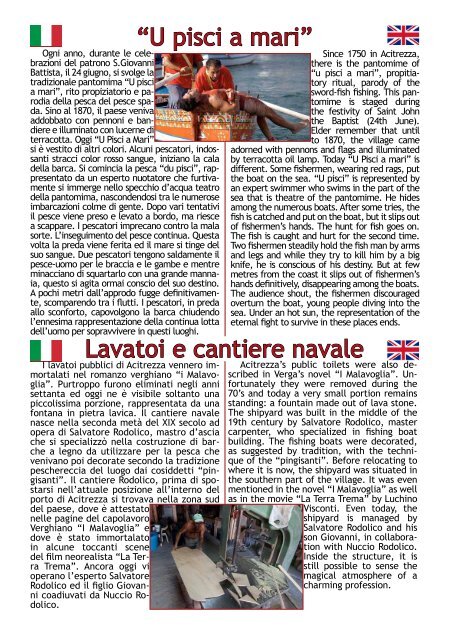Guida turistica Aci Trezza 2013 - Xiphonia Coop. a rl - Turismo ad ...
Guida turistica Aci Trezza 2013 - Xiphonia Coop. a rl - Turismo ad ...
Guida turistica Aci Trezza 2013 - Xiphonia Coop. a rl - Turismo ad ...
Create successful ePaper yourself
Turn your PDF publications into a flip-book with our unique Google optimized e-Paper software.
Ogni anno, durante le celebrazioni<br />
del patrono S.Giovanni<br />
Battista, il 24 giugno, si svolge la<br />
tr<strong>ad</strong>izionale pantomima “U pisci<br />
a mari”, rito propiziatorio e parodia<br />
della pesca del pesce sp<strong>ad</strong>a.<br />
Sino al 1870, il paese veniva<br />
<strong>ad</strong>dobbato con pennoni e bandiere<br />
e illuminato con lucerne di<br />
terracotta. Oggi “U Pisci a Mari”<br />
si è vestito di altri colori. Alcuni pescatori, indossanti<br />
stracci color rosso sangue, iniziano la cala<br />
della barca. Si comincia la pesca “du pisci”, rappresentato<br />
da un esperto nuotatore che furtivamente<br />
si immerge nello specchio d’acqua teatro<br />
della pantomima, nascondendosi tra le numerose<br />
imbarcazioni colme di gente. Dopo vari tentativi<br />
il pesce viene preso e levato a bordo, ma riesce<br />
a scappare. I pescatori imprecano contro la mala<br />
sorte. L’inseguimento del pesce continua. Questa<br />
volta la preda viene ferita ed il mare si tinge del<br />
suo sangue. Due pescatori tengono saldamente il<br />
pesce-uomo per le braccia e le gambe e mentre<br />
minacciano di squarta<strong>rl</strong>o con una grande mannaia,<br />
questo si agita ormai conscio del suo destino.<br />
A pochi metri dall’approdo fugge definitivamente,<br />
scomparendo tra i flutti. I pescatori, in preda<br />
allo sconforto, capovolgono la barca chiudendo<br />
l’ennesima rappresentazione della continua lotta<br />
dell’uomo per sopravvivere in questi luoghi.<br />
“U pisci a mari” Since 1750 in <strong>Aci</strong>trezza,<br />
there is the pantomime of<br />
“u pisci a mari”, propitiatory<br />
ritual, parody of the<br />
sword-fish fishing. This pantomime<br />
is staged during<br />
the festivity of Saint John<br />
the Baptist (24th June).<br />
Elder remember that until<br />
to 1870, the village came<br />
<strong>ad</strong>orned with pennons and flags and illuminated<br />
by terracotta oil lamp. Today “U Pisci a mari” is<br />
different. Some fishermen, wearing red rags, put<br />
the boat on the sea. “U pisci” is represented by<br />
an expert swimmer who swims in the part of the<br />
sea that is theatre of the pantomime. He hides<br />
among the numerous boats. After some tries, the<br />
fish is catched and put on the boat, but it slips out<br />
of fishermen’s hands. The hunt for fish goes on.<br />
The fish is caught and hurt for the second time.<br />
Two fishermen ste<strong>ad</strong>ily hold the fish man by arms<br />
and legs and while they try to kill him by a big<br />
knife, he is conscious of his destiny. But at few<br />
metres from the coast it slips out of fishermen’s<br />
hands definitively, disappearing among the boats.<br />
The audience shout, the fishermen discouraged<br />
overturn the boat, young people diving into the<br />
sea. Under an hot sun, the representation of the<br />
eternal fight to survive in these places ends.<br />
Lavatoi e cantiere navale<br />
I lavatoi pubblici di <strong>Aci</strong>trezza vennero immortalati<br />
nel romanzo verghiano “i Malavoglia”.<br />
Purtroppo furono eliminati negli anni<br />
settanta ed oggi ne è visibile soltanto una<br />
piccolissima porzione, rappresentata da una<br />
fontana in pietra lavica. Il cantiere navale<br />
nasce nella seconda metà del XIX secolo <strong>ad</strong><br />
opera di Salvatore Rodolico, mastro d’ascia<br />
che si specializzò nella costruzione di barche<br />
a legno da utilizzare per la pesca che<br />
venivano poi decorate secondo la tr<strong>ad</strong>izione<br />
peschereccia del luogo dai cosiddetti “pingisanti”.<br />
Il cantiere Rodolico, prima di spostarsi<br />
nell’attuale posizione all’interno del<br />
porto di <strong>Aci</strong>trezza si trovava nella zona sud<br />
del paese, dove è attestato<br />
nelle pagine del capolavoro<br />
Verghiano “I Malavoglia” e<br />
dove è stato immortalato<br />
in alcune toccanti scene<br />
del film neorealista “La Terra<br />
Trema”. Ancora oggi vi<br />
operano l’esperto Salvatore<br />
Rodolico ed il figlio Giovanni<br />
co<strong>ad</strong>iuvati da Nuccio Rodolico.<br />
<strong>Aci</strong>trezza’s public toilets were also described<br />
in Verga’s novel “I Malavoglia”. Unfortunately<br />
they were removed during the<br />
70’s and today a very small portion remains<br />
standing: a fountain m<strong>ad</strong>e out of lava stone.<br />
The shipyard was built in the middle of the<br />
19th century by Salvatore Rodolico, master<br />
carpenter, who specialized in fishing boat<br />
building. The fishing boats were decorated,<br />
as suggested by tr<strong>ad</strong>ition, with the technique<br />
of the “pingisanti”. Before relocating to<br />
where it is now, the shipyard was situated in<br />
the southern part of the village. It was even<br />
mentioned in the novel “I Malavoglia” as well<br />
as in the movie “La Terra Trema” by Luchino<br />
Visconti. Even today, the<br />
shipyard is managed by<br />
Salvatore Rodolico and his<br />
son Giovanni, in collaboration<br />
with Nuccio Rodolico.<br />
Inside the structure, it is<br />
still possible to sense the<br />
magical atmosphere of a<br />
charming profession.


